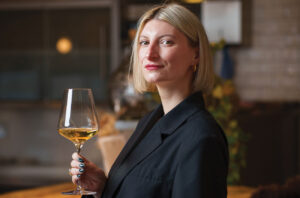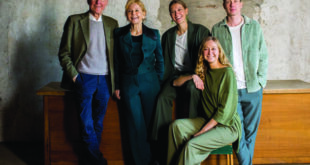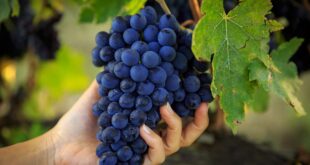
Head sommelier at Restaurant Pine (one Michelin and one Green Michelin star), in Northumberland, Vanessa Stoltz was raised in Alsace. Her father worked in the trade and she picked up the family passion for wine early, developing it into a fledgling career during a season in the vineyards of Sancerre. Vanessa moved to England in 2016 to become a sommelier, and in 2018 she won the Champagne Gosset Matchmakers competition with her husband, chef Ian Waller. She passed her Court of Master Sommeliers introductory and certified sommelier exams in 2023, and has been included in two prestigious sommelier listings, marking her as one of the top somms in the UK.
Vanessa Stoltz profile image credit: Joe Taylor
When I began my journey with British wines, I wasn’t sure if I could pull it off, though it made sense to try. Coming from Alsace, I was used to seeing the wines of my local area dominating supermarket shelves, restaurant wine lists and so on. So why not do the same here, with English and Welsh wines? We have to start somewhere to build a reputation, and I was ready to take a risk. Besides, what could be more exciting than being part of a newborn wine country that has barely been discovered?
I won’t dwell too much on sparkling wines because, thanks initially to Nyetimber, the British versions gained world recognition some time ago. My favourites in this category are Gusbourne (Kent), Ancre Hill (Monmouthshire, Wales) and Hoffmann & Rathbone (Sussex). Rather, let’s talk about still wines – and not just whites, but also orange, rosé, red and sweet wines, made conventionally and as natural wines. These wines are hardly spoken about – Decanter’s panel tasting in the last (August) issue is a welcome exception – and OMG, they’re so tasty!
Isn’t it too rainy? Isn’t it too cold for grapes to ripen? Historically, maybe, but climate change is a reality, and someone has to benefit from it. However, it remains vital to choose the right grape varieties for the terroir. The Holy Trinity of Chardonnay, Pinot Noir and Meunier aside, other grapes have adapted well to the UK’s climate: in particular Bacchus, Siegerrebe, Müller-Thurgau and Solaris for whites, and Regent and Rondo for reds, to name a few. Most of these are of Germanic origin.
Bacchus thrives pretty much everywhere in England. I love to think it will become the country’s national grape. Its scent is of elderflower and blackcurrant leaves – the best versions have only a slightly grassy aroma – and the palate is zesty and refreshing. My favourites are the Bacchus by Freedom of the Press winery, made from Essex fruit; the Litmus Orange Bacchus from Surrey (2022, £20-£22.99 Hedonism, Grape Britannia, Litmus Wines, The English Vine, Virgin Wines); and New Hall Vineyard’s Purlai Gold sweet wine, again from Essex fruit. Dry Bacchus whites work with a diverse range of dishes – try cod or hake served with a creamy sauce, or broccoli and stilton pie.
The reds Rondo and Regent are completely different from each other in character, and are often blended. Regent is a fruit-driven, light-bodied grape, whereas Rondo has dark skin and juice. Blended together, they can create a smooth-bodied wine with ripe red and black fruit characters. The best examples are Three Choirs Vineyard’s Ravens Hill (Gloucestershire, 2023 £13.50) and White Castle’s Regent (Monmouthshire, 2022 £28). These go well with meat or vegetables served with barbecue sauce, or with a beetroot and hazelnut salad.
I can’t wait to see what the next chapter holds for British wines. Champagne houses are buying land, and some vineyards have planted Riesling, Merlot and Cabernet Sauvignon. What regulations will be put into place? Which grapes and regions will really take off? I would love to see you hop on this journey of endless possibilities.
Discover the still wines of Britain: Stoltz’s three to try
Danbury Ridge, Chardonnay, Essex 2021 (£34-£42.50 Widely available) Essex is the…
Source : https://www.decanter.com.master.public.keystone-prod-eks-euw1.futureplc.engineering/wine/the-sommelier-suggests-wines-of-britain-by-vanessa-stoltz-536749/



